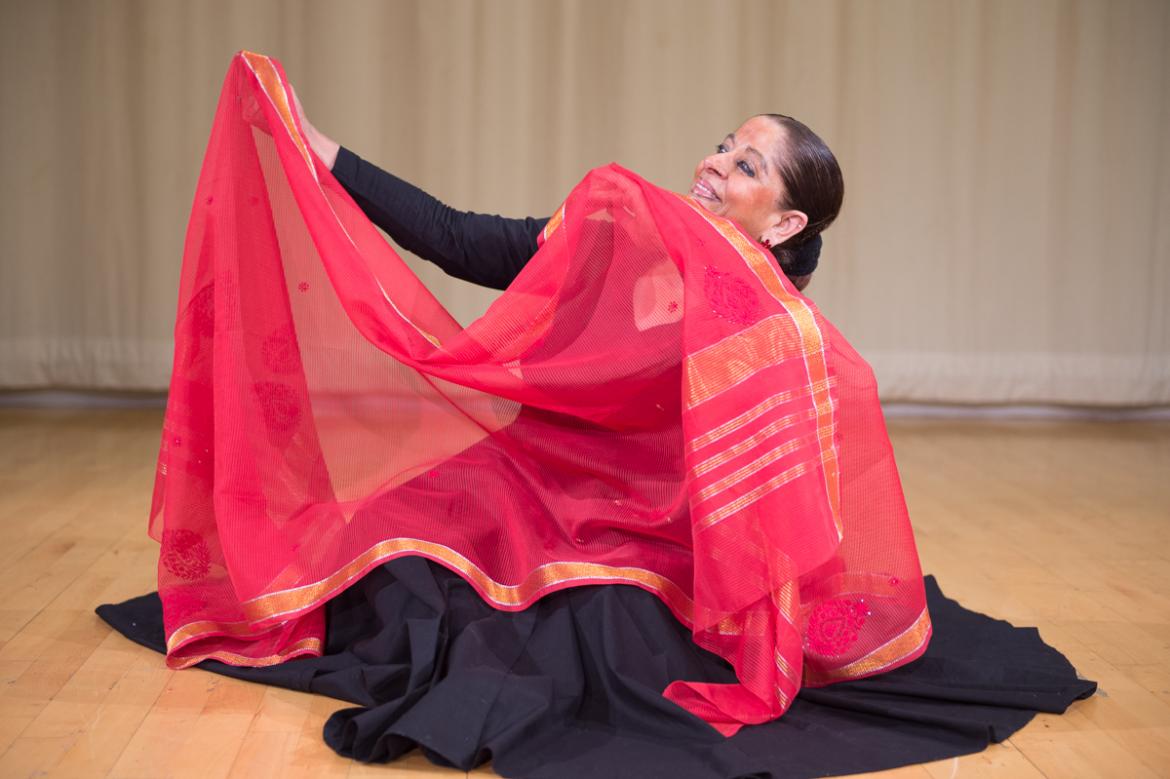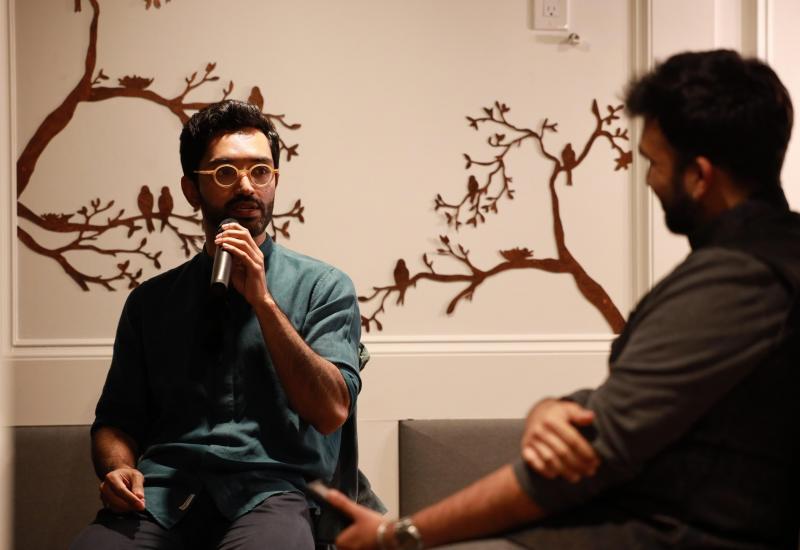“This is your prayer”– the kathak of Nahid Siddiqui
Nahid Siddiqui has contributed significantly to the understanding and practice of this art form in the UK and internationally. She has trained numerous students over the past thirty years in the UK and abroad and has performed to wide acclaim all over the world, receiving prestigious awards such as Pakistan’s Pride of Performance Award. She was awarded Milapfest’s Lifetime Achievement Award in October 2017. She is currently working on a book on kathak and she spoke to us about what guides her art.
Nahid Siddiqui grew up in a traditional family in Karachi and felt “lucky to have been born into a family that never hindered my growth”. She describes her mother as beautiful, and says she had an eye for beauty and aesthetics. Nahid’s father loved calligraphy and taught his daughter to write on a takhti (a small wooden board for writing on with a reed pen and ink). He also made sure that she walked well, with her spine properly aligned. He was jailed for a time under Ayub Khan’s martial law, when her mother took employment as a singer on the radio to support her children, discarding her burqa. Her father understood when he saw Nahid practising that her dance was an art and he said to her: “This is your prayer.” Nahid trained with Maharaj Ghulam Hussain Kathak in Pakistan and Pandit Birju Maharaj in India.
Her journey as a performer and instructor in kathak in the UK began in the late 1970s (at a time when her art was deemed un-Islamic in Pakistan) with dance classes at Bharatiya Vidya Bhavan, London. She went on to introduce it as part of the curriculum at the University of Surrey and set up her own dance company in Birmingham, where she is currently based.
Unwavering in her commitment to her art and using it as a means to channelise trauma and upheaval, Nahid Siddiqui has drawn immensely from the spirituality of Sufism and the physical and mental discipline of yoga to develop a style and repertoire that is uniquely hers.
What does kathak mean to you?
Kathak is a complete art form and part of sangeet. When I say complete, it encompasses alignment, posture, lines, painting, acting, singing, elegance, rhythm, harmony and one’s own stance in life.
Kathak is the song of the body, led by the soul, using the body as a tool and expanding to the horizons to radiate love, peace and beauty. As an instrument is tuned before it is played, we tune our strings within to bring out our emotions.
How has kathak evolved in the UK in the last three decades?
Kathak has taken new directions and has evolved to tell the stories of today. Many dancers are telling their own stories through non-traditional themes and sounds. I believe the real and pure technique of kathak or, for that matter, any classical dance, has to be mastered before experimenting or creating new vocabulary.
Does Birmingham feel like home to you and has it afforded you opportunities to develop your practice?
Birmingham has helped me develop my art in many ways. My relationship with Midlands Arts Centre (mac), Dorothy Wilson, the director of mac, who herself is a musician; Sampad and its director Piali Ray; and the community of artists…have made Birmingham very homely artistically.
I’ve worked with the Birmingham Royal Ballet. That opened new doors for my journey and provided a lifetime experience to advance my roots in many ways, in my training, in my approach and in the professionalism which I saw in the Birmingham Royal Ballet.
Your productions have been ground-breaking. Could you say something about some of them?
Tihai (1994) explored the work and philosophy of Rumi and Sufism. Rung (1995) was based on Hazrat Amir Khusrau’s work. It was Sufi-based and used qawwalis for the first time with kathak. Dhyana (2004) explored meditativeness from within. I felt it would be appropriate for Hariprashad Chaurasia from India to compose the music for Krishna (2004), which I choreographed for the Birmingham Royal Ballet – so it became a collaboration between India, Pakistan and the UK. Scene Unseen (2001) was about the elements – water, air, fire and earth – that are always there but are not always visible. When they become visible they can be soothing or destructive. Dancing in the Mist (1996) was philosophical but real.
What would you consider your finest achievement?
My achievement is the knowledge, love and respect of my teachers and being able to reach out to students and to dance and music lovers…it’s a joy because it never feels like work and I’m forever on holiday.
Whenever I receive an award or recognition I remember (my gurus) Baba Maharaj, Birju Maharaj<I>ji</I>, who showered on me their invaluable knowledge, faith, trust and love.
My finest achievement is my research into the vast ocean of kathak. I compare kathak with <I>khayal gayiki</I>, as when I dance, I sing. I feel like an archaeologist…digging deeper every day to unravel new marvels. Actual research and my findings will be in the book that I’m working on now.
How would you like to be remembered – as a dancer, a dance-maker or a teacher, or if all three, in what order?
I started my dance journey through performing; so first of all I am a dancer, then a teacher, and then a choreographer.
I feel the best student is the best teacher, as the quest for learning never dies in a real explorer and a student of life. One never arrives at the final point. If one looks at Mount Everest from below, it seems very difficult to climb so high, but if we take each step, [savouring] the moment, the joy in the journey leads us to unlimited heights.
To students aspiring to learn kathak, what lessons would you share?
Whoever comes to learn these divine arts is sensitive and what one has to do as their guide and teacher is give them respect and value their participation, because without them we just cannot take it forward. It’s all about distributing and showering the knowledge you have been given.
The real art is to realise the self, the positive self, as we are exposed externally and internally, especially when we dance. So, with all my students, I start working from within. Dance is not only the body dancing, the soul leads the body to participate, the limbs, emotions, they stem out from (the) centre of your heart, from your soul. That’s why I inculcate self-analytical power in students, which makes them freer, confident and non-commercial, and able to say ‘no’ on occasion if the dance is not treated with respect.
What tips would you give to teachers of dance?
Before moving the body one must work on one’s inner self through practices like meditation, yoga and seeing the silence within and without, as it is the silence of the soul which gives birth to movement.
Please do not play to the gallery; instead just become it, unaware of the applause.
Surrender the negative ego, recognise the lineage and acknowledge it.
What message would you like to give to dancers and organisations on inculcating a collaborative spirit among different dance forms?
A dancer shouldn’t only dance beautifully but also be able to see, watch others dance and really wholeheartedly become their dance, so that we are merging into the cosmos, other than singularly thinking about our own selves.
Do you see dance in any way contradictory to your religion? How have you coped with this criticism?
I feel that we generally confuse religion and spirituality. There’s a great difference. When a child is born into a Muslim family or a Hindu family or a Sikh family, they start to imbibe the rituals they see.
And religion, I feel, is related more with rituals rather than evoking the spiritual being. But dance, music, all the art forms, actually help to enhance the spiritual self. I see dance as the ultimate meditation, where each limb, each vein, each molecule is meditation through total focus.
Practices associated with disallowing art forms arise more to suit men of a certain society…(who try to) cage women and not really admit the beauty inside them or around them.
So if in religion, accepting and appreciating beauty is not allowed, then dance shouldn’t be allowed…trees should not be moving…water should not be dancing. I feel that I am above that, and I can just laugh off [such perceptions].
(With thanks to the Pulse magazine editors for their contributions.)












